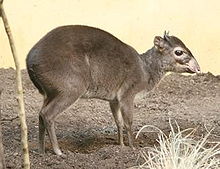
A duiker is a small to medium-sized brown antelope native to sub-Saharan Africa, found in heavily wooded areas. The 22 extant species, including three sometimes considered to be subspecies of the other species, form the subfamily Cephalophinae or the tribe Cephalophini.

Bushmeat is meat from wildlife species that are hunted for human consumption, most often referring to the meat of game in Africa. Bushmeat represents a primary source of animal protein and a cash-earning commodity for inhabitants of humid tropical forest regions in Africa, Latin America and Asia. Bushmeat is an important food resource for poor people, particularly in rural areas.

The Aders's duiker, also known as nunga in Swahili, kunga marara in Kipokomo and harake in Giriama, is a small, forest-dwelling duiker found only in Zanzibar and Kenya. It may be a subspecies of the red, Harvey's, or Peters's duiker or a hybrid of a combination of these. It is named after Dr. W. Mansfield Aders, a zoologist with the Zanzibar Government Service.

The bay duiker, also known as the black-striped duiker and the black-backed duiker, is a forest-dwelling duiker native to western and southern Africa. It was first described by British zoologist John Edward Gray in 1846. Two subspecies are identified. The bay duiker is reddish-brown and has a moderate size. Both sexes reach 44–49 cm (17–19 in) at the shoulder. The sexes do not vary considerably in their weights, either; the typical weight range for this duiker is 18–23 kg (40–51 lb). Both sexes have a pair of spiky horns, measuring 5–8 cm (2.0–3.1 in). A notable feature of this duiker is the well-pronounced solid stripe of black extending from the back of the head to the tail.

The black duiker, also known as tuba in Dyula, is a forest-dwelling duiker found in the southern parts of Sierra Leone, Liberia, Côte d'Ivoire, Ghana, Benin, and Nigeria.
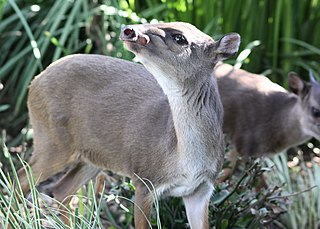
The blue duiker is a small antelope found in central, southern and eastern Africa. It is the smallest duiker. The species was first described by Swedish naturalist Carl Peter Thunberg in 1789. 12 subspecies are identified. The blue duiker reaches 32–41 centimetres (13–16 in) at the shoulder and weighs 3.5–9 kilograms (7.7–19.8 lb). Sexually dimorphic, the females are slightly larger than the males. The dark tail measures slightly above 10 centimetres (3.9 in). It has short, spiky horns, around 5 centimetres (2.0 in) long and hidden in hair tufts. The subspecies show a great degree of variation in their colouration. The blue duiker bears a significant resemblance to Maxwell's duiker.

Jentink's duiker, also known as gidi-gidi in Krio and kaikulowulei in Mende, is a forest-dwelling duiker found in the southern parts of Liberia, southwestern Côte d'Ivoire, and scattered enclaves in Sierra Leone. It is named in honor of Fredericus Anna Jentink.

The Maxwell's duiker is a small antelope found in western Africa.

The red-flanked duiker is a species of small antelope found in western and central Africa in countries as far apart as Senegal and Sudan. Red-flanked duikers grow to almost 15 in (35 cm) in height and weigh up to 31 lb (14 kg). They have russet coats, with greyish-black legs and backs, and white underbellies. They feed on leaves, fallen fruits, seeds and flowers, and sometimes twigs and shoots. The adults are territorial, living in savannah and lightly wooded habitats, and the females usually produce a single offspring each year. They have lifespans of ten to fifteen years in captivity.
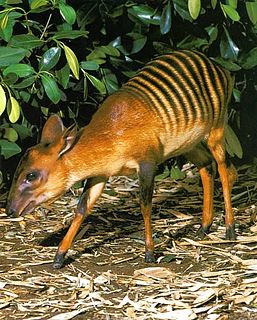
The zebra duiker is a small antelope found primarily in Liberia, as well as the Ivory Coast, Sierra Leone, and occasionally Guinea. They are sometimes referred to as the banded duiker or striped-back duiker. It is believed to be one of the earliest duiker species to have evolved.
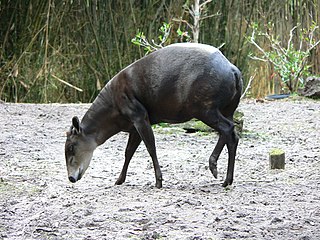
The yellow-backed duiker is a forest dwelling antelope in the order Artiodactyla from the family Bovidae. Yellow-backed duikers are the most widely distributed of all duikers. They are found mainly in Central and Western Africa, ranging from Senegal to Western Uganda with possibly a few in Gambia. Their range also extends southward into Rwanda, Burundi, Zaire, and most of Zambia.

Cephalophus is a mammal genus which contains at least fifteen species of duiker, a type of small antelope.

The wildlife of Togo is composed of the flora and fauna of Togo, a country in West Africa. Despite its small size the country has a diversity of habitats; there are only remnants of the once more extensive rain forests in the south, there is Sudanian Savanna in the north-western part of the country and larger areas of Guinean forest-savanna mosaic in the centre and northeast. The climate is tropical with distinct wet and dry seasons. There are estimated to be over 3000 species of vascular plant in the country, and 196 species of mammal and 676 species of bird have been recorded there.
Mont Sângbé National Park is a national park in Ivory Coast. The Encyclopædia Britannica lists it among the "principal national parks of the world". It acquired national park status in 1976.
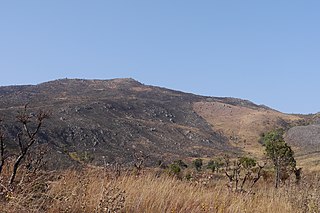
The Angolan montane forest-grassland mosaic ecoregion is located on the east-facing inland side of the belt of mountains that stands parallel to the coast of Angola, 50–100 km inland.
The Brooke's duiker is a species of antelope. It is distributed throughout Liberia, Sierra Leone and Côte d'Ivoire. It was elevated to species status.

Walter's duiker is a species of duiker found in Togo, Benin and Nigeria. It was described in 2010. Its name commemorates Professor Walter Verheyen, who was the first to obtain a specimen of this species of duiker from Togo in 1968.

The preorbital gland is a paired exocrine gland found in many species of hoofed animals, which is homologous to the lacrimal gland found in humans. These glands are trenchlike slits of dark blue to black, nearly bare skin extending from the medial canthus of each eye. They are lined by a combination of sebaceous and sudoriferous glands, and they produce secretions which contain pheromones and other semiochemical compounds. Ungulates frequently deposit these secretions on twigs and grass as a means of communication with other animals.

The white-legged duiker is a medium-sized antelope species from the subfamily of duikers (Cephalophinae) within the family of bovids (Bovidae). It is native to Gabon and the Republic of the Congo. It was described as subspecies of the Ogilby's duiker by Peter Grubb in 1978. After a revision of the ungulates in 2011 by Colin Groves, it is now regarded as distinct species.
